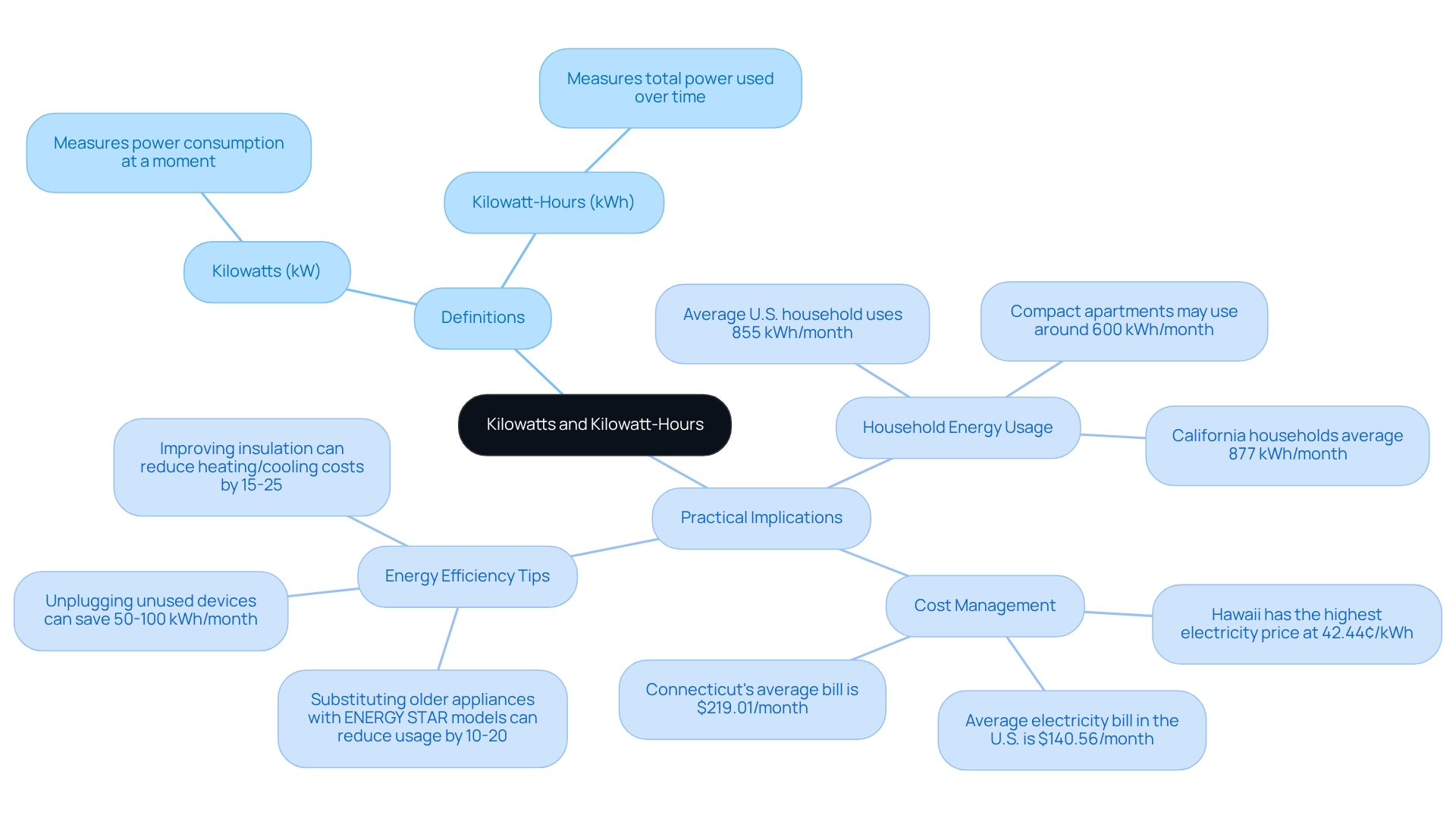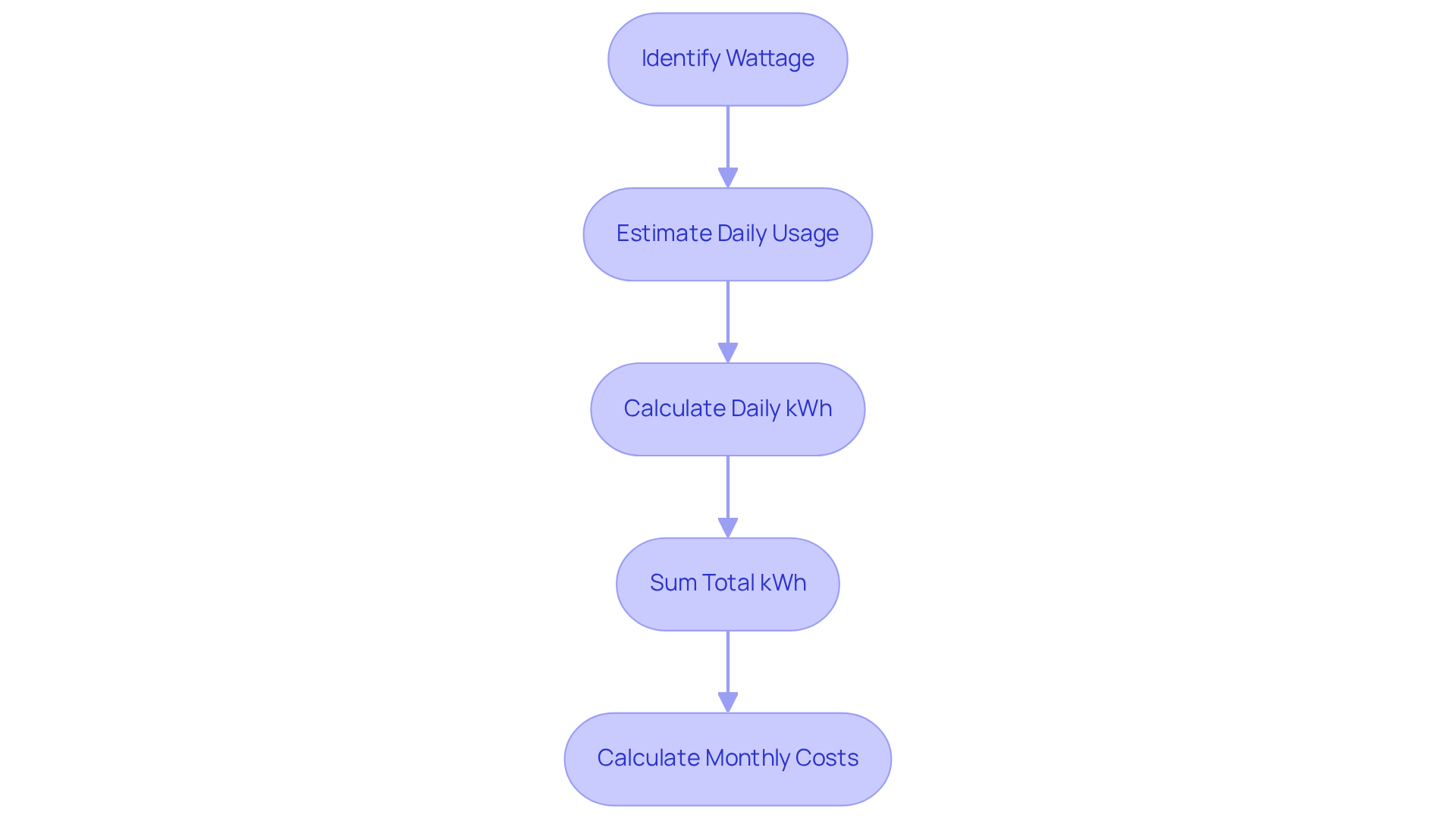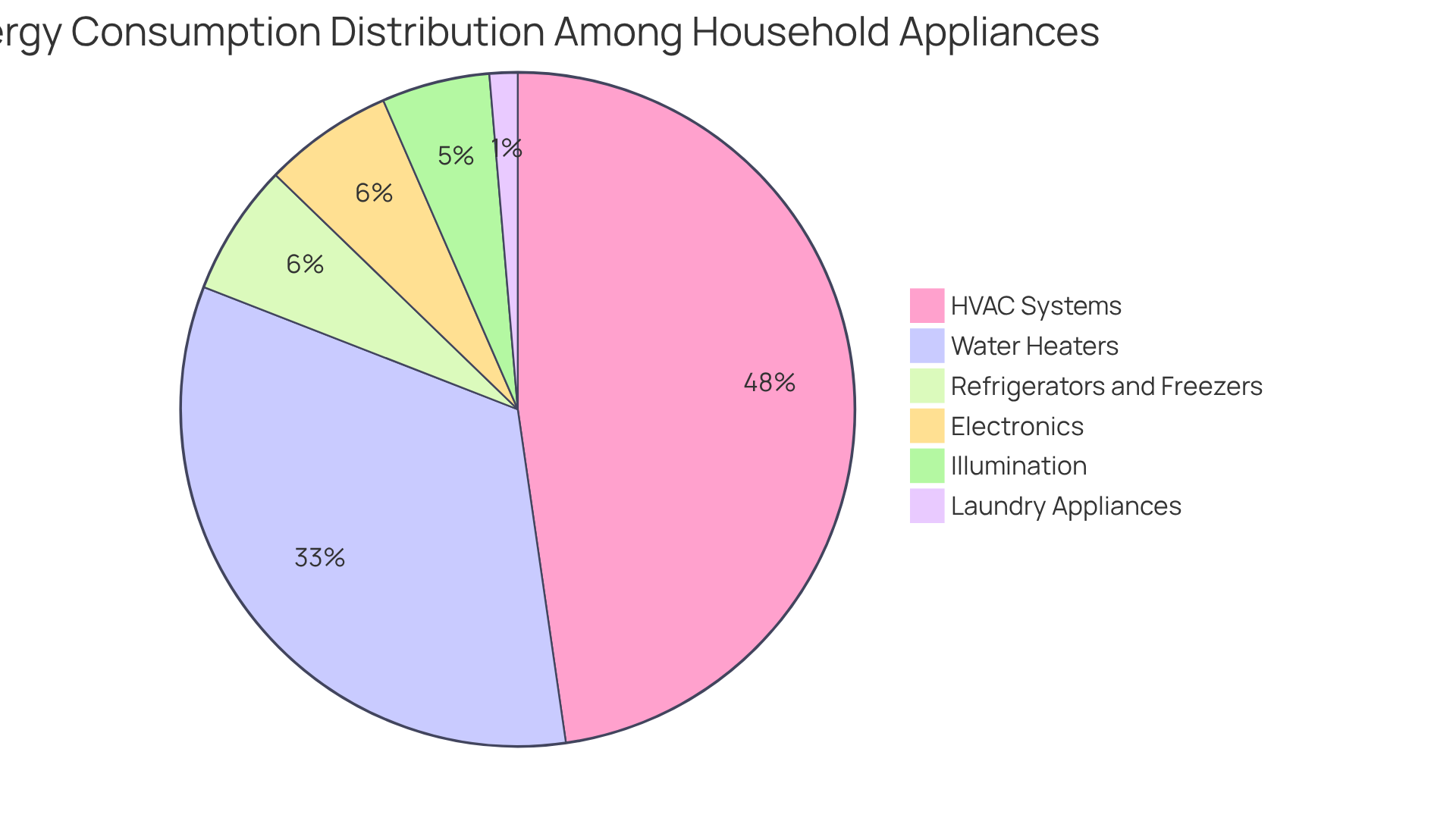Overview
This article addresses your concerns about energy bills by explaining how kilowatts (kW) and kilowatt-hours (kWh) function. Understanding these concepts is crucial for grasping energy use and discovering potential savings on your utility bills. We recognize that managing energy consumption can feel overwhelming, but we’re here to help you navigate this journey.
By providing practical steps for calculating energy consumption and costs, we aim to empower you with the knowledge needed to take control of your energy usage. We also highlight major energy-consuming appliances, allowing you to identify areas where you can make a difference. Together, we can explore effective strategies for reducing energy usage, which not only leads to financial savings but also contributes positively to our environment.
In this way, we hope to support you in making informed decisions that enhance your home’s energy efficiency. Remember, you’re not alone in this; let’s work towards a more sustainable future together, where your home can thrive while being kinder to the planet.
Introduction
We understand that understanding energy consumption can feel overwhelming, especially when confronted with the complexities of kilowatts and kilowatt-hours. These measurements are essential not only for managing your household electricity bills but also for making informed decisions about energy-efficient practices.
As homeowners like you strive to reduce costs and lessen environmental impact, the challenge often lies in deciphering how these units translate into real-world savings. What practical steps can we take together to optimize energy use and cut down on expenses?
This guide delves into the nuances of kilowatt-hours, offering insights and strategies that empower you to take control of your energy consumption and unlock significant savings. Together, we can navigate this journey toward a more sustainable and cost-effective future.
Define Kilowatts and Kilowatt-Hours
Kilowatts (kW) gauge the rate of power consumption or production at any given moment. For instance, a 1 kW device utilizes 1,000 watts of power. On the other hand, a kilowatt-hour (kWh) measures the total power used over time. If you operate a 1 kW device for one hour, it uses 1 kWh of power. Understanding this distinction is vital for grasping how do kWh work in relation to your power bills, as utility companies charge based on the number of kWh consumed during a billing cycle.
We understand that managing energy costs can feel overwhelming. In California, the typical household uses roughly 877 kWh each month, which aligns closely with the average U.S. household usage of about 855 kWh monthly. By comprehending these measurements, homeowners can recognize opportunities for savings. For example, consider substituting older appliances with ENERGY STAR-certified models; this can lower consumption by 10-20%. Additionally, small habits like unplugging unused devices can prevent an extra 50-100 kWh in monthly usage, a common practice among many households. Moreover, the typical electricity charge in the United States is $140.56 each month, underscoring the financial implications of power usage.
For eco-conscious homeowners contemplating solar power, understanding how do kWh work is crucial for assessing your home’s power requirements and selecting the appropriate solar panel inverters. By precisely evaluating your power usage, you can select solar options that enhance storage and efficiency, ensuring that your investment in solar technology meets your household’s needs. As consumption specialist Hannah Bastawrose states, “Comprehending your usage is the first step towards making informed choices that can lead to substantial savings.” Together, we can navigate these choices and work towards a more sustainable future.
Calculate Your Energy Consumption and Costs
Understanding your energy consumption and its associated costs can feel overwhelming, but we’re here to help. To get started, follow these simple steps:
- Identify the wattage of each device: Check the label on your devices to find their wattage. This is the first step in understanding how much energy you’re using.
- Estimate daily usage: Consider how many hours each device is used daily. This information is crucial for understanding how do kWh work in accurate calculations.
- Calculate daily kWh: Use the formula: (Wattage × Hours Used) ÷ 1000 = Daily kWh. This will help you understand how do kWh work in relation to your daily energy consumption.
- Sum total kWh: Add the daily kWh of all appliances to get your total daily usage. This step helps you see the bigger picture.
- Calculate monthly costs: Multiply your total daily kWh by 30 (days) and then by your electricity rate (in cents per kWh) to find your monthly cost. For instance, if your total daily consumption is 30 kWh and your rate is $0.30 (the average electric rate in California as of 2025), your monthly cost would be 30 kWh × 30 days × $0.30 = $270.
By grasping these calculations, homeowners can pinpoint opportunities to lower utility expenses. It’s common to feel concerned about high energy bills, but assessing the consumption of high-wattage devices, such as HVAC systems, can lead to significant savings. In fact, these systems can represent approximately 40% of overall utility expenses, with air conditioning alone accounting for 19% of overall power consumption in residences.
Implementing energy-efficient practices can lead to meaningful reductions in your monthly bills, with some homeowners reporting savings of up to 10%, translating to approximately $298 annually. Furthermore, the typical household in the United States utilizes around 861 kWh of electricity each month, which serves as a useful benchmark for evaluating your usage and understanding how do kWh work. Together, we can explore resource usage calculator tools available online to aid in these calculations and help you take steps towards energy independence. Remember, every small change can make a difference, and we’re here to support you on this journey.
Identify Major Energy-Consuming Appliances
Understanding how do kwh work can be overwhelming, but identifying the major energy-consuming appliances in your home is a great first step towards taking control. Let’s explore some key areas where you might be using more energy than you realize:
-
Heating and Cooling Systems: Your HVAC system likely accounts for the largest share of your power use, often representing about 46% of your home’s overall consumption. It’s common to feel concerned about this significant expense, but knowing is the first step to making changes.
-
Water Heaters: If you have an electric tankless water heater, it may consume around 3,500 kWh annually if used for four hours a day. Older models can be even more power-hungry, contributing significantly to your utility costs. Recognizing this can help you consider more efficient options.
-
Refrigerators and Freezers: These appliances run continuously and can be major power consumers, averaging about 657 kWh per year. Their energy usage can vary based on age and efficiency—older models often use much more power. Reflecting on the age of your appliances might inspire you to consider an upgrade.
-
Laundry Appliances: Washing machines typically use around 2,100 watts, costing approximately £1.09 per hour. On average, they consume about 140 kWh per year based on three loads of laundry weekly. Dryers can be even more demanding, averaging 2,500 watts, translating to about £1.30 per hour. Understanding these costs can help you adjust your laundry habits.
-
Illumination: Lighting often goes undervalued, yet it can contribute significantly to your energy use, especially if you’re still using incandescent bulbs. Transitioning to energy-saving LED bulbs can reduce your lighting power usage by up to 90%. Imagine the savings and the positive impact on the environment!
-
Electronics: Devices like televisions and computers can also add to your utility expenses, particularly when left on standby. Consumer electronics account for approximately 6% of total household power usage, and many devices use electricity even when not in operation, a phenomenon known as ‘idle load’ or ‘vampire power.’
By gaining a clearer understanding of how do kwh work and how these devices impact your energy consumption, you can make informed choices that will not only lower your utility expenses but also improve your overall efficiency. Together, we can work towards a more sustainable and cost-effective home environment.
Implement Strategies to Reduce Energy Usage
Are you feeling overwhelmed by your energy bills? You’re not alone, and there are compassionate ways to address this concern. To help you reduce energy usage in your home, consider these nurturing strategies:
- Upgrade to Energy-Efficient Appliances: Seek out ENERGY STAR-rated devices that consume less power, helping both your wallet and the planet.
- Utilize Smart Thermostats: These devices can adapt heating and cooling schedules to your habits, minimizing unnecessary power consumption and ensuring comfort.
- Seal and Insulate: Proper insulation and sealing of windows and doors can prevent heat loss in winter and keep your home cool in summer, creating a cozy environment.
- Switch to LED Lighting: By substituting incandescent bulbs with LED bulbs, you can consume up to 80% less power, making a significant impact on your energy use.
- Unplug Devices: Many electronics still consume energy when turned off. Using power strips allows you to easily disconnect multiple devices, saving energy effortlessly.
- Practice Energy-Conscious Habits: Simple actions like turning off lights when leaving a room, using cold water for laundry, and reducing shower times can lead to significant savings.
Together, we can make a difference. By implementing these strategies, not only will you see a reduction in your energy bills, but you’ll also contribute to a more sustainable future. Let’s work towards energy independence and create a home that reflects our values. If you need support or guidance, don’t hesitate to reach out—we’re here for you.
Conclusion
Understanding how kilowatt-hours (kWh) function is essential for managing energy consumption and reducing costs effectively. We understand that many homeowners worry about their energy bills, and by grasping the difference between kilowatts and kilowatt-hours, you can make informed decisions that lead to significant savings on your utility bills. This knowledge empowers you not only to track your energy use but also to implement strategies that promote efficiency and sustainability.
Throughout this article, we’ve shared key insights on:
- Calculating energy consumption
- Identifying major energy-consuming appliances
- Adopting practical strategies to reduce energy usage
From recognizing the impact of HVAC systems to considering energy-efficient appliances, each point underscores the importance of being proactive in energy management. By following the outlined steps, you can take charge of your energy consumption and discover ways to lower your monthly expenses.
Ultimately, every small change contributes to a larger goal of energy independence and environmental sustainability. Embracing energy-efficient practices and making informed choices can lead to substantial savings while also benefiting our planet. As awareness grows around energy use and its implications, it’s common to feel overwhelmed, but it becomes increasingly vital for us to engage in this conversation and take actionable steps towards a more sustainable future. Together, we can make a difference and work towards a brighter, more energy-efficient tomorrow.





